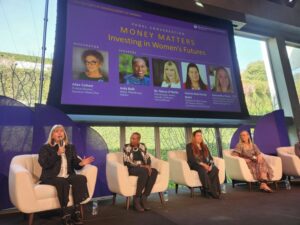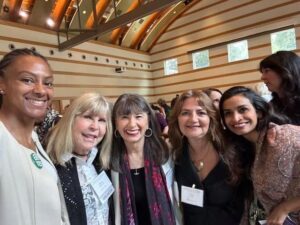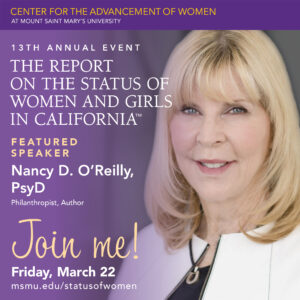 In 2012, Mount Saint Mary’s University released its inaugural edition of The Report on the Status of Women and Girls in California, and it has since become a valuable resource for advocates, business leaders, elected officials, and engaged citizens. This year was no different. As organizers prepared for the event, tickets went quickly and by the day of the event, it was standing room only.
In 2012, Mount Saint Mary’s University released its inaugural edition of The Report on the Status of Women and Girls in California, and it has since become a valuable resource for advocates, business leaders, elected officials, and engaged citizens. This year was no different. As organizers prepared for the event, tickets went quickly and by the day of the event, it was standing room only.
Ann McElaney-Johnson, PhD, and President, Mount Saint Mary’s University wrote that they were initially inspired to create the Report because, “As a women’s university, we had an inherent and abiding interest in the forces that shape young women’s lives. And while that first edition’s findings showed us that California women were making great strides toward equity in some areas, it also revealed that striking gender gaps still existed. Now in our thirteenth year, this Report continues to shine a light on gender inequities wherever they persist in our state. More importantly, as I also noted in that first letter, we continue to remember that ‘recognizing those gaps is the first step toward finding solutions.’”
 In the 2024 Report, The Cost of Being a Woman: Solutions for Economic Equity, authors investigated the underlying causes of economic gender inequities and the real cost of living for California women and girls. They also looked hard at how women are charged more for essentials, paid less in the workplace, expected to provide more unpaid caregiving labor, and have less access to investment capital. The report examined ways that it ultimately costs more for a woman – or a girl – to be financially, physically, and emotionally well in California, while also considering possible solutions.
In the 2024 Report, The Cost of Being a Woman: Solutions for Economic Equity, authors investigated the underlying causes of economic gender inequities and the real cost of living for California women and girls. They also looked hard at how women are charged more for essentials, paid less in the workplace, expected to provide more unpaid caregiving labor, and have less access to investment capital. The report examined ways that it ultimately costs more for a woman – or a girl – to be financially, physically, and emotionally well in California, while also considering possible solutions.
Some of the Report’s key takeaways include:
- California women earn 89% of what all men earn for full-time work. Over the past decade, this gap has closed by 5 percentage points. However, this is due to wage increases for white women and Asian American women.
- The earnings gap has stayed consistent for Latinas and increased for Black women. In addition, women make up two-thirds of the lowest-paid workers in California’s workforce.
- California is home to the greatest number of women-owned businesses of any U.S. state. Businesses solely or equally owned by women employ 2.6 million Californians and boast a combined payroll of $113 billion.
- Nationwide, the economy is losing money by not investing in women. Startups founded solely by women receive just 2% of all venture capital. This is despite the fact female founders generate 78 cents of revenue for every investment dollar — compared to a 31-cent return on funding for male-founded startups.
- In 2020, California women paid an average of $2,381 more than men for the same goods and services per year. In 2022, the California legislature passed the Pink Tax law to address that hidden cost.
- U.S. women spend on average 55 minutes daily working on their appearance — adding up to an entire two-week vacation every year. This results in using about 13 products every day for body, skin, and hair care, plus cosmetics. The cost of beauty adds up quickly, with women spending an average of $3,756 a year on products and services.
 This list goes on and on. For most California women, the clearest path to economic independence can be found in access to well-paying jobs. But in California, as it is in the rest of the country, women have to contend with the pay gap, gendered occupations, minimal savings that keep a “a college degree — and its transformative earnings power — out of reach.”
This list goes on and on. For most California women, the clearest path to economic independence can be found in access to well-paying jobs. But in California, as it is in the rest of the country, women have to contend with the pay gap, gendered occupations, minimal savings that keep a “a college degree — and its transformative earnings power — out of reach.”
While this year’s Report is impressive, the speakers at the event were top notch. From Eve Rodsky, New York Times Bestselling Author and Holly Martinez, Executive Director, California Commission on the Status of Women and Girls, to our partners Zakiya Thomas, President & CEO, ERA Coalition and the Fund for Women’s Equality, Frederique Irwin, President and CEO, National Women’s History Museum, to Dr. Nancy O’Reilly, Founder and President of Women Connect4Good, Inc., attendees had the opportunity to learn from experts in numerous fields.
Dr. Nancy joined a panel conversation, Money Matters: Investing in Women’s Futures, to discuss why, “We must invest IN women and AS women to move the needle on inequality.” When asked how she is connecting the dots between national and California women’s issues she said, “I’ve found that women’s issues are not isolated to one specific part of the country. To make a difference, start where you are and look for the common issues. I look for big and little ways to make an impact and urge others to do the same. We’re all in this together, and as we recognize our common goals and connect with one another, we strengthen our potential to make a difference and create meaningful, positive change.”
When the panel discussed their role in promoting financial literacy to the next generation, Dr. Nancy said, “Money is a vehicle. Many women do not seem to understand their self-worth and the impact of that can be devastating. Knowing your value is key. That means we need to lead by example and teach younger generations to act with confidence when asking for raises, negotiating salaries, or advancing to better positions. We need to encourage them get comfortable being uncomfortable because that’s where the money is.”
Attendees not only left the event with the Report, they left with actionable items to help move progress forward, including several action items from our Lift Women Up campaign – which provides more than an opportunity to do good, it is women helping women in action and proves that we can go further if we go together. To learn more about this year’s event or to get a copy of the report, go to Mount Saint Mary’s University’s website.

